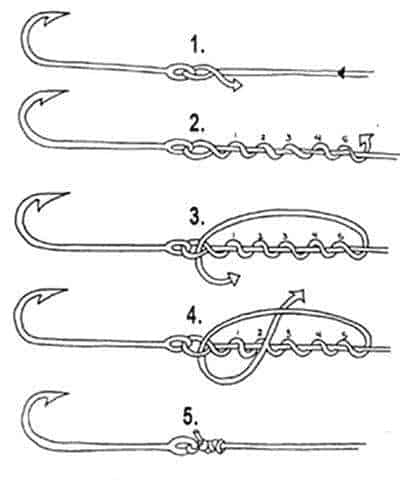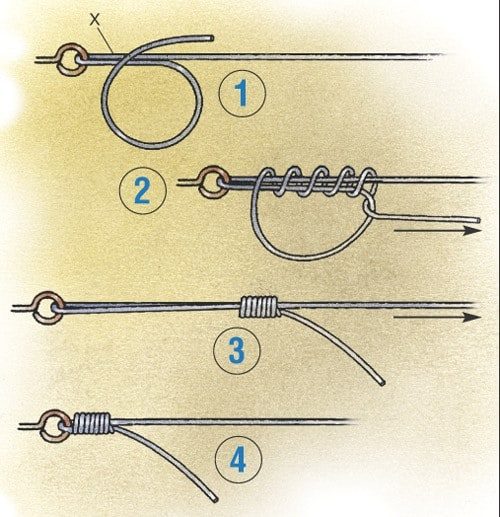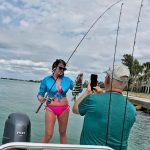The Best Fishing Knot is the Uni Knot
This article will discuss the best fishing knot. Strong, well tied knots are very important when it comes to fishing. They keep the fish connected to the angler. There are many excellent fishing knots that can be chosen. However, there is one fishing knot that is the best knot to use.
The best fishing not is the Uni knot. This is true for several reasons. Uni knots are very strong. They are also one of the easiest and quickest knots to tie. Finally, the Uni knot is quite versatile and can be used in variation to match every fishing situation that an anglers will encounter.
Capt Jim Klopfer has been a fishing guide in Sarasota, Florida since 1991. He has tried just about every fishing knot out there. As a charter boat captain, he requires a knot that is strong and fast and easy to tie. The Uni knot meets those requirements and is the only knot that Capt Jim uses.
Most fishing knots are a variation of the same principle. The line goes through the eye of the hook or lower, is wrapped around the running line several times, then goes back through and is cinched tight. The Uni knot is no exception. However, there are a couple of distinctions that make the Uni not the best fishing not.
The uni knot is the best fishing knot
First and foremost, the Uni knot is quick and very easy to tie. This is important for charter boat captains who have to re-rig quickly and efficiently. It also comes into play for anglers fishing in low light conditions where the line is more difficult to see. Finally, when a blitz is on, anglers can confidently and quickly tie a Uni knot.
Strength is extremely important when it comes to fishing knots. The Uni knot is one of the strongest ones out there, when properly tied. It works well with both monofilament and braided line, which is not true of every fishing knot.
check out my post on the best freshwater fishing tackle and lures
Uni knots are also quite versatile. By pulling the tag line tight instead of the running line, anglers can make a very effective loop knot. Uni knots are also a very easy way to tie multiple hooks on some type of dropper rig for bottom fishing or any other situation where more than one hook or lure is used. Finally, a double Uni knot is an excellent way to tie a piece of leader to the main line without having to use a swivel.
Tying the uni knot
The Uni knot is very easy to tie. The first step is to pass the line through the eye of the hook with about 6 inches of excess line to use to tie the knot. The angler then makes a loop pinching all three portions of the line between the thumb and forefinger. The tag end is then passed through the open loop 3 to 5 times when using monofilament line and 8 to 10 times when using braided line. The tag end is then slowly pulled snug. When properly done, the line will wrap over itself in a figure 8 manner. It does not hurt to wet monofilament line before pulling it tight. Once the knot is snug, the angler pulls on the running line to slide the knot down to the eye of the hook or lure. The tag end can then be trimmed. If a loop not is desired, the angler can finish up the knot by pulling tight on the tag and and trimming that end of the knot.
Variations of the uni knot
One variation of the Uni knot is to tie a double Uni knot. This is an excellent line to line knot, used to attach two pieces of fishing line without the use of a swivel. This can include a fluorocarbon leader to monofilament, two pieces of monofilament, two pieces of braid, or a monofilament leader attaching to braided line.

The double uni-knot is tied very similarly, with a little bit of difference. Both lines are laid over top of each other, with the tag end facing in different directions. A Uni knot is tied on one and, then the line flipped over and another one tied on the other end. The two knots are then pulled snug, resulting in a nice compact and strong knot.
Uni knots also work very well when tying dropper rigs when bottom fishing or when using multiple lures on one rig. The line is passed through the eye of the hook or lure, then a Uni not is tied. Once the size of the loop is the desired size, the tag end is pulled tight. This can then be repeated as many times as needed.
More useful fishing knots
Capt Jim also used another knot in his fishing system. That knot is a spider hitch. Capt Jim uses a simple system for all of his saltwater fishing. He doubles the running line for about three feet using a spider hitch. He then attaches the leader (usually 24″-30″) using a double uni knot. The hook or lure is then tied on the terminal end of the leader using a uni knot. This double line accomplished several things. It eliminates the need for a swivel. If the leader was tied to a single line, it would cut into it, reducing the strength significantly. Doubling the line takes that out of play.
The double line also acts like a shock leader when using monofilament line. This added stretch has saved more than one fish from pulling loose at the boat. Finally, there has been many times when one of the two strands has been cut. With a single line, the fish would have been lost. The double line reduces the chance of a fish getting off due to line abrasion. The illustration below describes it well. When properly done, it will easily slip through the rod tip and guides.

There are several other popular fishing knots that anglers can use successfully. As mentioned earlier, they all basically work the same. The line passes through the eye, around several times, then back through. The improved clinch knot and palomar knot are two very popular fishing knots.
Improved clinch knot
The improved clinch knot has been around a very long time. It was the knot that Capt Jim used before he became a fan of the uni knot. The improved clinch knot is easy to tie and quite strong. Anglers should definitely wet the line before pulling it taught. It is not as versatile as the uni knot, but is excellent for tying on a hook or lure. The tag end should not be trimmed too close, it can slip a tad.

Palomar knot
Many anglers consider the Palomar knot to be the strongest fishing knot. It is a bit more difficult and time consuming to tie, though it is easily mastered. A loop has to pass completely over the hook or lure. This is fine with a hook, can can get more complicated with a larger lure sporting multiple treble hooks. Still, it is an excellent fishing knot to add to the arsenal, if desired.

In conclusion, this article on the best fishing knot will help anglers land more fish






